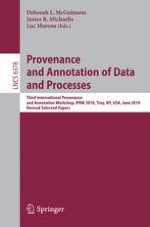2010 | Buch
Provenance and Annotation of Data and Processes
Third International Provenance and Annotation Workshop, IPAW 2010, Troy, NY, USA, June 15-16, 2010. Revised Selected Papers
herausgegeben von: Deborah L. McGuinness, James R. Michaelis, Luc Moreau
Verlag: Springer Berlin Heidelberg
Buchreihe : Lecture Notes in Computer Science
